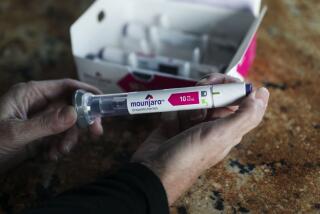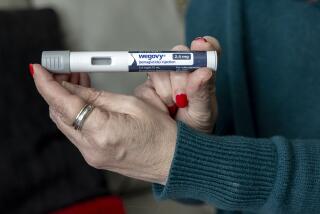Study Dilutes the Wine Theory
It was fun while it lasted, that notion that washing down your meatloaf with a glass or two of red wine might make you healthier--after all, it worked for the French.
Now researchers in Britain are pouring cold water over the idea that all that quaffing of Bourdeaux and Burgundy has much to do with France’s low incidence of heart disease.
The more likely cause for the low rate is that the French only relatively recently began consuming appreciable quantities of dietary fats, the team reports in Saturday’s British Medical Journal. They conclude that France is poised on the brink of a massive increase in heart disease.
The core of the issue is that mortality from ischemic heart disease--that is, heart disease of unknown origin--in France is only about one-quarter the mortality in Britain, even though people in the two countries consume roughly equivalent amounts of fat and have comparable blood cholesterol levels. This so-called “French paradox” has intrigued researchers for nearly two decades.
Some have attributed the French paradox to protective effects of the garlic and onions that are common in French cooking, but there is no direct evidence that these foods have any protective effect. Many researchers favor the wine theory, which has been around since the French paradox was first discovered. Many studies have shown that a glass of wine per day or the equivalent can reduce heart disease by about 20%. But the studies also show that drinking more confers no additional benefit.
Dr. Nicholas Wald and Malcolm Law of the Royal London School of Medicine and Dentistry have a more intriguing theory. Although the British and French currently have comparable fat consumption and blood levels of cholesterol, that has not always been the case. Until about 1970, the French had much lower levels of both consumption and blood cholesterol, after which their levels began rising.
Wald and Drew argue that, just as smoking does not cause lung cancer immediately, high fat intake also takes many years to produce heart disease. Although it is not yet clear what this lag time is, it most likely is about two to three decades. And if that is the case, they say, France should brace itself for an epidemic of heart failure.
Low Doses of Estrogen May Promote Cancer
Estrogen is rarely used alone in hormone replacement therapy because it increases one’s risk of developing endometrial cancer. Generally, it is combined with progestogen, which counteracts estrogen’s growth-promoting properties. But low doses of estrogen are frequently given to treat atrophy of vaginal and urethral epithelium (the tissues that line the vagina and urethra) because such low doses are not thought to promote cancer.
That idea is wrong, Swedish researchers report in Saturday’s Lancet. Dr. Elisabete Weiderpass and her colleagues at the Karolinska Institutet in Stockholm studied 709 women with endometrial cancer and compared them to 3,368 who did not have it. They concluded that the low doses of estrogen doubled the risk of endometrial cancer, while use for more than five years tripled the risk. But they also concluded that the increased risk disappeared quickly when the women stopped taking the oral medication.
UV Lights Tested in ‘Sick Buildings’
Ultraviolet lights installed in air conditioning vents can alleviate the symptoms of sick building syndrome, according to a pilot study conducted by researchers at McGill University in Montreal. The UV lights kill bacteria and fungi that would normally be spread through the ventilation system to produce a variety of symptoms, including headache, fatigue, difficulty concentrating and respiratory problems.
Dr. Dick Menzies reported in the June issue of Occupational and Environmental Medicine that employees reported fewer symptoms during weeks when the lights were on than during those when they were turned off. Because the lights were in ventilation ducts, employees were not placed at risk by potentially damaging ultraviolet exposure, and were unaware whether the lights were on or off.
Hospitals and Heart Attack Survival Rates
If you are having a heart attack, your chances of survival are greater if you go to a large medical center than if you go to a smaller, neighborhood hospital, according to researchers at Johns Hopkins University. They report in Thursday’s New England Journal of Medicine that survival rates are 17% higher at hospitals that handle a high volume of heart patients. For patients ages 65 to 69, the chance of survival is 30% higher. If all heart attack patients were sent to high-volume hospitals, those handling more than five cases per week, at least 5,000 lives would be saved each year, they said.
Pricey New Heart Drug Doesn’t Beat the Old
Newer--and more expensive--is not always better. The first head-to-head comparison of a new beta-blocker called carvedilol (Coreg) against an older drug, metoprolol, in treating congestive heart failure has found that the two drugs are equal in effect. Carvedilol, however, costs three times as much.
Dr. Marrick L. Kukin and his colleagues at Mount Sinai Medical Center in New York City studied 46 men and 21 women with congestive heart failure. They report in Tuesday’s Circulation: Journal of the American Heart Assn., found that, after six months of treatment, the drugs were equally effective in increasing stamina, improving the heart’s pumping ability and boosting levels of antioxidants. The study was funded by the manufacturer of carvedilol.
Gene Linked to Panic Disorder
Canadian researchers have found a genetic marker for panic disorder, a psychiatric condition characterized by frequent episodes of severe panic attacks. A team from the University of Toronto reports in the March issue of Molecular Psychiatry, released Thursday, that victims of the disorder have a specific variant of the gene that serves as the blueprint for a protein called the cholecystokinin-B receptor. The discovery should help diagnosis of the disorder and could lead to future treatments.
Survey Says Hospitals Overdo Blood Samples
Hospitals draw up to 10 times more blood than they need for medical tests, according to a survey of 19 hospitals published in Thursday’s New England Journal of Medicine. Dr. Jocelyn M. Hicks of Children’s National Medical Center in Washington did the study after spending two weeks as a patient in an intensive care unit. She discovered that so much of her blood was drawn for tests that the volume of oxygen-carrying red cells in her blood dropped from 43% to 31%.
In her survey, Hicks found a wide gap between the amount of blood drawn for tests in 12 community and university hospitals, and the amount taken at seven children’s hospitals, where doctors are careful not to drain too much blood from their sometimes tiny patients.
*
Thomas H. Maugh II can be reached via e-mail at thomas.maugh@latimes.com.






